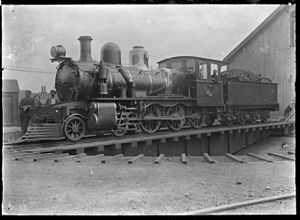NZR UC class
| NZR UC class | |
|---|---|
|
UC Class 368 soon after arrival in New Zealand in about 1901 | |
| Type and origin | |
| Builder | Sharp, Stewart and Company |
| Build date | 1901 |
| Total produced | 10 |
| Specifications | |
| Configuration | 4-6-0 |
| Gauge | 3 ft 6 in (1,067 mm) |
| Driver diameter | 49.125 in (1.248 m) |
| Weight on drivers | 26.8 long tons (27.2 tonnes; 30.0 short tons) |
| Locomotive and tender combined weight | 62.6 long tons (63.6 tonnes; 70.1 short tons) |
| Fuel type | Coal |
| Boiler pressure | 200 lbf/in2 (1,379 kPa) |
| Firegrate area | 17 sq ft (1.6 m2) |
| Heating surface: – Total | 975 sq ft (90.6 m2) |
| Cylinders | Two, outside |
| Cylinder size | 16 in × 22 in (406 mm × 559 mm) |
| Performance figures | |
| Tractive effort | 18,340 lbf (81.58 kN) |
| Career | |
| Operator(s) | NZR |
The NZR UC class were a group of ten 4-6-0 steam locomotives obtained from Scottish builders Sharp, Stewart and Co. Essentially they were developments of the firm's previous batch of 4-6-0s' for NZR.
Origin and design
Due to an increase in traffic around the turn of the century, NZR obtained 47 4-6-0 locomotives to provide additional capacity. All were used in the South Island. The UC class were the last new 4-6-0's to be delivered, entering service between August and October 1901 .[1] They were briefly classified U .[2] Externally they were similar in appearance to Sharp Stewart's earlier UA class, but with a longer cylinder stroke and considerably higher boiler pressure (200 psi as opposed to 175 psi) they had a significantly higher tractive effort. All of the locomotives began service in the Christchurch area aside from two allocated to the Dunedin - Invercargill section.
Service
With the opening of the Otira Tunnel in 1923 all ten were gradually transferred to the West Coast of the South Island. Due to weight restrictions they were the most powerful mainline locomotives on the West Coast until the 1940s. In the late 1920s and 1930s seven locomotives were fitted with narrow firebox superheated boilers [3] and lever type reverse controls in place of the original wheel and screw type. Other alterations included fitting sand domes and a new type of funnel. The remaining three locomotives were withdrawn by 1937.
The superheated boilers on the UCs provided better performance and from the mid 1930s they saw considerably greater use than their Baldwin built UB stable mates.[2] They were still being used on passenger services as well as their staple coal trains in the mid 1950s, however the arrival of more A Class locomotives in the 1950s (displaced by dieselisation in the North Island) allowed their withdrawal by 1959. Although none were initially preserved a number were dumped in rivers as erosion prevention measures, and two have been recovered for potential restoration.
Class register
| Key: | In service | Out of service | Auckland Transport service | Preserved | Overhaul/Repair | Scrapped |
|---|
| Number | Builder | Builder's NO | Entered service | Withdrawn | Notes |
|---|---|---|---|---|---|
| 361 | Sharp Stewart | 4745 | 16-08-1901 | 1-1957 | Dumped at Omoto, July 1958. |
| 362 | Sharp Stewart | 4746 | 7-08-1901 | 10-1958 | Dumped at Omoto, July 1959. |
| 363 | Sharp Stewart | 4747 | 28-9-1901 | 8-1936 | |
| 364 | Sharp Stewart | 4748 | 28-9-1901 | 2-1957 | |
| 365 | Sharp Stewart | 4749 | 7-10-1901 | 10-1959 | Dumped at Omoto, May 1961. |
| 366 | Sharp Stewart | 4750 | 10-10-1901 | 8-1936 | Dumped at Oamaru, c. 1936. Remains recovered in 2008 by ONTRACK, now owned by Oamaru Steam & Rail and placed on static display. |
| 367 | Sharp Stewart | 4751 | 12-10-1901 | 10-1955 | |
| 368 | Sharp Stewart | 4752 | 18-10-1901 | 12-1934 | |
| 369 | Sharp Stewart | 4753 | 21-10-1901 | 01-1957 | Dumped at Omoto, May 1958. Recovered in 2005 by the Midland Rail Heritage Trust, currently stored at Springfield. |
| 370 | Sharp Stewart | 4754 | 24-10-1901 | 01-1957 | Dumped at Omoto, May 1958. Recovered in 2005 by the Midland Rail Heritage Trust, currently stored at Springfield. |
Preservation
In March 2005, the newly formed Midland Rail Heritage Trust in conjunction with a family of private individuals salvaged the remains of UC 369 and UC 370 from the Grey River. The locomotives had fallen into the Grey River in 1997-98 during a period of bad weather; both were recovered with the remains of their tenders and are currently stored at the MRHT's Springfield depot pending completion of a workshop to restore them in.
In 2008, the remains of UC 366 were recovered by ONTRACK during an exercise to remove as many of the locomotive remains dumped at Oamaru which were at risk of being lost due to deterioration of the dumpsite. The badly deteriorated remains of the UC were passed to the Oamaru Steam & Railway Society, who have placed it on display at their workshops along with another selection of salvaged locomotive parts.
References
Citations
- ↑ McClare 1988, p. 91.
- ↑ 2.0 2.1 Millar 2011, p. 246.
- ↑ McClare 1991, p. 175.
Bibliography
- Lloyd, W.G.; Register of New Zealand Railways Steam Locomotives 1863-1971, Rogan-McIndoe Print Ltd., 2002
- McClare, E. J. (1991). Steam Locomotives of New Zealand: Volume Three 1930-1971. New Zealand Railway & Locomotive Society. ISBN 0-908573-58-8.
- Millar, Sean (2011). The NZR Steam Locomotive. New Zealand Railway & Locomotive Society. ISBN 978-0-908573-89-9.
- Stewart, W.W., When Steam Was King, Reed, 1970
External links
| ||||||||||||||||||||||||||||||||||||||||||||||||||
